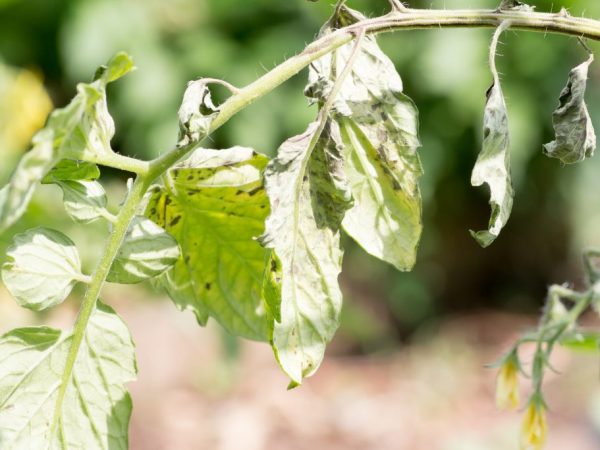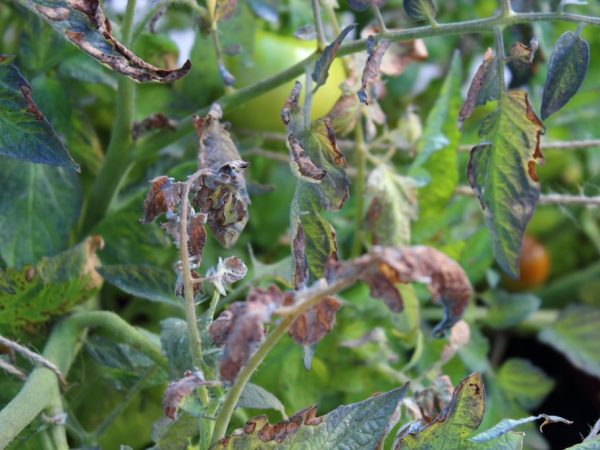How to deal with tomato brown spot
Brown spot on tomatoes can destroy up to 80% of the tomato crop. Only the adoption of timely preventive measures and timely treatment started can effectively fight the infection and preserve tomato plantings.

Fighting tomato brown spot
Causative agent of infection
Tomato brown spot is a fungal disease. The causative agent of cladosporium is a fungus that infects tomato crops through the spread of conidia. Fungal conidia of brown spotted infection differ from simple fungal spores in origin: unlike cladosporium fungi that produce spores in special organs of sporangia, conidia grow directly on the mycelium, are light in weight, are similar to dust particles, therefore they quickly spread from infected plants to healthy tomato bushes ...
Most often, brown fungal infection affects the leaves of tomato bushes grown in open soil or in greenhouses without heating systems.
Brown spot fungal conidia get on tomatoes by air, through water, and are also transferred to household equipment. Fungal conidia can maintain their viability even without a host plant, retaining activity in winter among plant debris, in soil, on the surface of the earth and on greenhouse structures. They are quite resistant to both high and low temperatures, they survive when dried.
Provoking factors
The most important favorable condition for the rapid spread of cladosporiosis is excessive moisture, at which conidia begin to reproduce. The most effective indicator of humidity for disease activity is an indicator exceeding 90%.
Symptoms
You can usually notice the presence of signs of a brown fungal infection on tomato bushes in the middle of the vegetative development of plants. At this time, the vegetable crop begins to actively gain strength for flowering and the formation of ovaries.
Among the main signs of tomato cladosporiosis are:
- yellow spots on the outside of the leaf blades, having various sizes and shapes,
- a light-colored bloom on the inside of tomato leaves, which eventually changes color to dark and brown, subsequently the structure of the bloom changes to a more dense one in quality and becomes velvety due to germinating fungal conidia.
With the initial signs of brown spot on tomatoes, failure to take timely measures leads to a change in the color shade of the tomato foliage and their shape. Tomato leaves subsequently begin to turn yellow, dry out and, after a certain period of time, crumble.
At the first stages of the defeat of brown spot fungi on tomatoes, weakened foliage dies, due to the loss of which, the process of photosynthesis in the plant is disrupted.The lack of produced organic matter by tomato bushes leads to a violation of the fruiting stage and reduces the amount of yield.
Cladosporiosis treatment
Brown spot of tomatoes can be cured by folk methods and through the use of chemicals.
Traditional methods

Infusion of garlic will help heal plants
As folk remedies in the treatment of cladosporia, recreational watering and spraying is often used:
- Garlic. Tomato bushes are sprayed with infusions with garlic, for which the chopped seasoning in the amount of 0.5 kg (cloves and garlic arrows) is soaked in a 10-liter volume of water and kept for a day.
- Potassium permanganate and ash. The alternation of watering with water with potassium permanganate of low concentration with ash mixtures (300 g per 1-2 liters of water is heated to the boiling point and then brought to 10 liters) allows you to effectively fight brown fungal infection at the initial stages of plant damage.
Chemicals
In the absence of effectiveness from the use of folk remedies to save the tomato crop in the treatment of brown spot on tomatoes, one has to resort to the use of chemicals:
- processing of tomato bushes with contact agents of the Bravo series is carried out by spraying the leaves with a repeat after 7-10 days,
- it is recommended to spray Phytolavin with a chemical agent when large acreage of tomatoes is affected, repeating the treatment in the greenhouse twice, in conditions of growing in the open field - at least 3-4 times.
When using chemicals for the treatment of brown fungal infection, the use of fruits is allowed no earlier than after 3 weeks.
Preventive measures
Timely prevention allows to prevent the defeat of tomato plantings with a brown infection.
Fitosporin
Most often, Fitosporin is used for prophylactic purposes against cladosporium, solutions with which the soil is watered immediately before planting tomato seeds and seedlings. In addition, Fitosporin is added to water for watering tomato bushes in the process of further caring for them after planting. For preventive purposes, the drug is used for spraying tomato plantings with an interval of 2 weeks.
Yeast
For prophylaxis against brown spot on tomatoes, simple culinary yeast is suitable, 100 g of which is diluted in 10 liters of water.
Agrotechnics
Compliance with the basic agrotechnical measures helps to prevent the defeat of the tomato crop by cladosporium:
- it is advisable to follow the rules of crop rotation, alternating the cultivation of different crops on the same planting area,
- after harvesting, it is important to destroy the remnants of vegetation from its predecessors,
- maintaining humidity at the required level of 60-70% will prevent fungal conidia from developing,
- Selecting disease-resistant tomato varieties will reduce the risk of disease.


